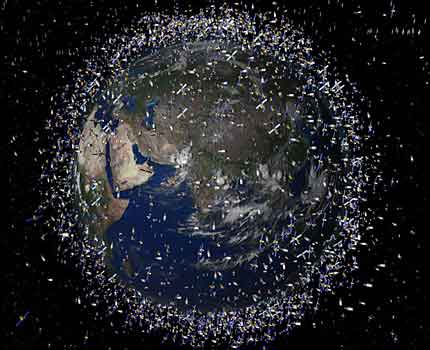 |
|
File photo of the debris orbiting the Earth. The amount of debris orbiting the Earth has reached "a tipping point" for collisions, according to a study. (Agencies) |
|
The amount of debris orbiting the Earth has reached "a tipping point" for collisions, which would in turn generate more of the debris that threatens astronauts and satellites, according to a US study released on Thursday. NASA needs a new strategic plan for mitigating the hazards posed by spent rocket bodies, discarded satellites and thousands of other pieces of junk flying around the planet at speeds of 17,500 miles (28,164 kilomtres) per hour, the National Research Council said in the study. The council is one of the private, nonprofit US national academies that provide expert advice on scientific problems. Orbital debris poses a threat to the approximately 1,000 operational commercial, military and civilian satellites orbiting the Earth -- part of a global industry that generated $168 billion in revenues last year, Satellite Industry Association figures show. The world's first space smashup occurred in 2009 when a working Iridium communications satellite and a non-operational Russian satellite collided 490 miles (789 km) over Siberia, generating thousands of new pieces of orbital debris. The amount of orbital debris tracked by the US Space Surveillance Network jumped from 9,949 cataloged objects in December 2006 to 16,094 in July 2011, the National Research Council said. The surveillance network tracks objects approximately 10 centimeters in diameter and larger. Some computer models show the amount of orbital debris "has reached a tipping point, with enough currently in orbit to continually collide and create even more debris, raising the risk of spacecraft failures," the research council said in a statement released Thursday as part its 182-page report. "The current space environment is growing increasingly hazardous to spacecraft and astronauts," Donald Kessler, the former head of NASA's Orbital Debris Program Office who chaired the study team, said in a statement. (Read by Christine Mallari. Christine Mallari is a journalist at the China Daily Website.) (Agencies)
|
據(jù)美國(guó)上周四發(fā)布的一份報(bào)告,地球軌道上太空垃圾的數(shù)量已經(jīng)達(dá)到“臨界點(diǎn)”,有撞擊風(fēng)險(xiǎn),而后可能產(chǎn)生更多碎片,威脅宇航員和人造衛(wèi)星的安全。 美國(guó)全國(guó)研究委員會(huì)在報(bào)告中稱(chēng),美國(guó)宇航局需要制定新的戰(zhàn)略計(jì)劃,以減小火箭殘骸、報(bào)廢衛(wèi)星、以及數(shù)千塊其它太空垃圾的危害。這些軌道太空垃圾時(shí)速高達(dá)1.75萬(wàn)英里(28164公里)。 該委員會(huì)是一家私立的非贏利性國(guó)家科研機(jī)構(gòu),致力于為科學(xué)難題提供專(zhuān)家建議。 衛(wèi)星產(chǎn)業(yè)協(xié)會(huì)發(fā)布的數(shù)據(jù)顯示,太空垃圾對(duì)地球軌道上空的大約一千個(gè)運(yùn)行中的商用、軍用、民用衛(wèi)星構(gòu)成威脅。全球衛(wèi)星產(chǎn)業(yè)每年收入高達(dá)1680億美元。 全球首例空間撞擊發(fā)生在2009年,當(dāng)時(shí)正在運(yùn)轉(zhuǎn)的一個(gè)銥通信衛(wèi)星和一個(gè)俄羅斯報(bào)廢衛(wèi)星在西伯利亞上空490英里(789公里)處發(fā)生撞擊,產(chǎn)生了數(shù)千個(gè)新的太空垃圾。 美國(guó)全國(guó)研究委員會(huì)稱(chēng),美國(guó)空間監(jiān)測(cè)網(wǎng)跟蹤并登記在冊(cè)的太空垃圾數(shù)量在2006年12月為9949個(gè),而在2011年7月就上升到了16094個(gè)。 該監(jiān)測(cè)網(wǎng)的監(jiān)測(cè)對(duì)象是直徑10厘米以上的太空垃圾。 美國(guó)全國(guó)研究委員會(huì)在上周四發(fā)布的一份聲明中指出,根據(jù)某些計(jì)算機(jī)模型,太空垃圾的數(shù)量已經(jīng)“達(dá)到臨界值,目前在軌的垃圾數(shù)量足以發(fā)生頻繁撞擊,并由此產(chǎn)生更多的垃圾碎片,從而增大損毀航天器的風(fēng)險(xiǎn)。”這份報(bào)告長(zhǎng)達(dá)182頁(yè)。 研究小組負(fù)責(zé)人唐納德?凱斯勒在聲明中說(shuō):“目前的太空環(huán)境對(duì)飛行器和宇航員來(lái)說(shuō)越來(lái)越危險(xiǎn)。”凱斯勒曾擔(dān)任美國(guó)宇航局軌道垃圾項(xiàng)目辦公室負(fù)責(zé)人。 相關(guān)閱讀 英國(guó)人預(yù)測(cè)2025年人類(lèi)將登上火星 設(shè)計(jì)師為日本女宇航員打造時(shí)尚太空服 Waste in Space 地球軌道 ‘清道夫’計(jì)劃 報(bào)廢衛(wèi)星 defunct satellite (中國(guó)日?qǐng)?bào)網(wǎng)英語(yǔ)點(diǎn)津 Julie 編輯:陳丹妮) |
|
Vocabulary: tipping point: 臨界點(diǎn) spent: used up or exhausted; consumed(用過(guò)的,失去效能的) smashup: a serious collision between vehicles; a wreck(猛撞,粉碎) |
